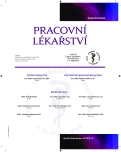Etiological factors of occupational rhinitis in the Slovak Republic
Authors:
Perečinský Slavomír
Authors‘ workplace:
Klinika pracovného lekárstva a klinickej toxikológie LF Univerzity P. J. Šafárika a Univerzitnej Nemocnice L. Pasteura, Košice
prednosta doc. MUDr. Ľubomír Legáth, PhD.
Published in:
Pracov. Lék., 65, 2013, No. 3-4, s. 121-125.
Category:
Original Papers
Overview
Occupational rhinitis (OR) belongs to most frequent occupational diseases of upper respiratory tract, occurring two to four times more often than occupational asthma. Prevalence and incidence of occupational rhinitis have not been specifically investigated, though. There proved to be marked regional differences in numbers of acknowledged cases in Slovakia. Numerous studies in the Košice region followed etiology of the disease as well. However, results of a single region are not necessarily applicable for the Slovak Republic at large. The objective of this investigation was to determine and compare possible differences in etiology of OR in the Košice region, where the disease is most frequent with other Slovakian regions. The study encompassed a group of 70 patients who were the subjects of occupational rhinitis acknowledgement in Slovakia in the 1990–2011 years. The group was divided in two groups. The first group included the OR cases in the Košice region. In the second group there were patients from other regions of Slovakia. The flour proved to be the most frequent cause in both groups (44% cases in both groups). Chemical compounds figured much more frequently in the Košice region than in the other regions. On the contrary occupational allergy to moulds represented up to 18% of OR cases in the other regions, whereas in the Košice region it did not occur. A general analysis determined relatively low number of etiological agents, indicating insufficient diagnostics of the disease. The spectrum of agents in the two groups differed relatively little, most often represented by classical allergens, where hypersensitivity can be proved by classical examination by immunoallergology methods. In numerous cases identification of OR requires nasal provocation tests or exposure tests directly at the workplace, which helps to better identify numerous agents and consequently improves the diagnostics of the disease.
Keywords:
occupational rhinitis – etiological factors – nasal provocation tests
Sources
1. Boušová, K., Krčmová, I., Ranná, D. Přínos nazálního provokačního testu pro diagnostiku profesionální alergické rinitídy. Pracov. Lék., 2006, roč. 58, č. 2, s. 57–61.
2. EAACI TaskForce on Occupational Rhinitis, Moscato, G., Vandenplas, O. et al. Occupational rhinitis. Allergy, 2008, 63, 8, s. 969–980.
3. Gautrin, D., Desroisies, M., Castano, R. Occupationa rhinitis. Curr. Opin. Allergy Clin. Immunol., 2006, roč. 6, č. 2, s. 77–84.
4. Hellgren, J. Occupational rhinosinusitis. Curr. Allergy Asthma Rep., 2008, roč. 8, č. 3, s. 234–239.
5. Hytonen, M. The risk of occupational rhinitis. Int. Arch. Occup. Environ. Health, 1997, 69, s. 487–490.
6. Kanerva, L., Vaheri, E. Occupational allergic rhinitis in Finland. Int. Arch. Occup. Environ. Health, 1993, roč. 64, č. 8, s. 565–568.
7. Klimentová, G., Buchancová, J., Figurová, K. Profesionálne alergické ochorenia v materiáli KPLaT MFN Martin. České pracovní lékařství, 2006, č. 3, s. 114–116.
8. Legáth Ľ. Úskalia diagnostiky profesionálnej astmy. I-med., 2013, ISSN 1338-4392.
9. Legáth, Ľ. Choroby z povolania v Slovenskej republike z pohľadu klinického lekárstva. Pracov. Lék., 2010, roč. 62, č. 4, s. 184–189.
10. Mäkelä, R., Kauppi, P., Suuronen, K., Tuppurainen, M., Hannu, T. Occupational asthma in professional cleaning work: a clinical study. Occup. Med. (Lond), 2011, roč. 61, č. 2, s. 121–126.
11. Moscato, G., Siracusa, A. Rhinitis guidelines and implications for occupational rhinitis. Curr. Opin. Allergy Clin. Immunol., 2009, 9, 2, s.110–115.
12. Perečinský, S. Etiologické faktory profesionálnej astmy vo Východoslovenskom regióne – retrospektívna štúdia. Klinická imunológia a alergológia, 2013, (v tlači).
13. Perečinský, S., Jančová, A. Profesionálna astma a profesionálna rinitída – jedny dýchacie cesty, jedno ochorenie? Pracov. Lék., 2012, roč. 64, č. 4, s. 164–168.
14. Perečinský, S., Jančová, A., Varga, M., Legáth, Ľ. Retrospektívny pohľad na epidemiológiu profesionálnych ochorení dýchacích ciest. Aký bude vývoj v ďalších rokoch? Pracov. Lék., 2012, roč. 64, č. 1, s. 13–17.
15. Perečinský, S., Legáth, Ľ. Postavenie nazálnych expozičných testov v diagnostike profesionálnej rinitídy. Pracov. Lék., 2009, roč. 61, č. 1, s. 21–26.
16. Perečinský, S., Legáth, Ľ. Profesionálna rinitída – stále poddiagostikované ochorenie? Slovenský lekár, 2009, roč. 19, č. 7–8, s. 126–130.
17. Piipari, R., Keskinen, H. Agents causing occupational asthma in Finland in 1986–2002: cow epithelium bypassed by moulds from moisture-damaged buildings. Clin. Exp. Allergy, 2005, roč. 35, č. 12, s. 1632–1637.
18. Siracusa, A., Desrosiers, M., Marabini, A. Epidemiology of occupational rhinitis: prevalence, aetiology and determinants. Clin. Exp. Allergy, 2000, roč. 30, s. 1519–1534.
19. Siracusa, A., Folletti, I., Moscato, G. Non-IgE-mediated and irritant-induced work-related rhinitis. Curr. Opin. Allergy Clin. Immunol., 2013, roč. 13, č. 2, s. 159–166.
20. Slavin, R. G. Occupational rhinitis. Ann. Allergy Asthma Immunol., 1999, roč. 83, č. 6, s. 597–601.
21. Sublett, J. W., Bernstein, D. I. Occupational rhinitis. Curr. Allergy Asthma Rep., 2010, roč. 10, č. 2, s. 99–104.
22. Varga, M., Legáth, Ľ. Intervencie na pracovisku pri liečbe profesionálnej astmy. I-med, 2012, ISSN 1338-4392.
23. Varga, M., Legáth, Ľ., Lepóris, D. Expozičné testy u pracovníkov v riziku organických prachov. České pracovní lékařství, 2006, č. 3, s. 170–173.
Labels
Hygiene and epidemiology Hyperbaric medicine Occupational medicineArticle was published in
Occupational Medicine

2013 Issue 3-4
Most read in this issue
- Syndrome of carpal tunnel
- Hypertension disease and health capability for work
- Health risks of exposure to dust at work
- Effects of glass fibers on selected parameters of respiratory tract in experimental conditions
